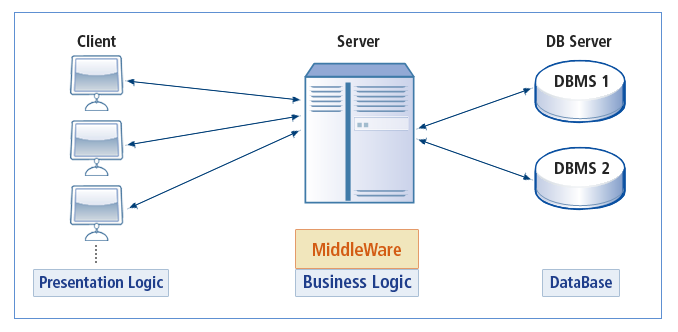Introduction to TP-Monitor
This chapter describes the concepts and functions of middleware and TP-Monitor to facilitate a better understanding of Tmax.
1. Overview
TP-Monitor (Transaction Processing Monitor) is the transaction management middleware that monitors transactions and maintains their consistency. A transaction is the smallest unit of handling among sessions, systems, and databases that operate via various protocols.
Since Tmax is a product based on TP-Monitor, this chapter first describes middleware and TP-Monitor.
2. Middleware
As the centralized mainframe environment began to encounter various operational and cost-related issues, it became necessary to downsize the environment to an open distributed system environment that separates hosts by application.
However, an open, distributed environment has issues involving the compatibility and integration between server programs. Additionally, communication between different operating systems have to be managed in multiple distributed systems because applications are handled in a single mainframe. As a result, multiple systems, server programs, and network resources must be used in a single user environment.
The following tables describe the issues of the two environments.
-
Centralized Mainframe Environment
Category Issue Cost
-
High adoption cost
-
High maintenance cost
Operation
-
Does not consider a user environment because the mainframe environment takes precedence over the application process.
System
-
Difficult to communicate between heterogeneous systems
-
Difficult to migrate a program to another system
-
Difficult business expansion
-
-
Open Distributed System Environment
Category Issue Cost
-
Requires professional technical skills for network, DBMS, etc.
Operation
-
Inefficient system operation
-
User environment not considered
-
Management issues in a distributed environment
-
Difficulty in managing and monitoring the system
-
Difficulty in handling failures
-
Differences in operating methods for multiple servers
-
Issues due to multiple providers
-
Performance degradation due to increasing users
-
Load differences between servers
System
-
Difficulties in managing processes
-
Requires multiple communication methods
-
Vulnerable system security
-
Difficulty in handling heterogeneous databases and global transactions
-
Difficulty in migrating programs between heterogeneous servers
-
Development issues (diverse OSs and development languages)
-
Provides transaction handling and process management features in the distributed environment with only a single middleware
-
Middleware has been developed to solve the open distributed environment issues.
Middleware is system software that provides a single user environment in a distributed computing environment. It connects a network of heterogeneous systems and supports communication between clients and servers, and connections between computers. Middleware enables stable communication in applications and in the operating environment by integrating heterogeneous hardware, protocols, and communication environments.
Clients and database servers do not need to directly communicate with each other because middleware engages in communication between the two systems. Since middleware has the business logic necessary for applications, clients and server programs only need to communicate with middleware. Clients and database servers can be configured into a single system environment through middleware. Middleware guarantees system integration for heterogeneous machines in a multiple database environment, and provides data compatibility and consistency. This environment provides maximum performance for minimal resources.
The following figure shows the client/server environment with middleware.

Middleware products can be divided into six types according to usage and purpose:
-
TP-Monitor (Transaction Processing Monitor)
Handles transactions in a heterogeneous distributed environment and manages various handling processes. Tmax belongs to this TP-Monitor product type.
-
WAS (Web Application Server)
Handles transactions on the web and provides the mutual communication feature (J2EE) to heterogeneous systems.
-
MOM (Messaging Oriented Middleware)
Handles messages by putting them into a queue and provides an asynchronous message management feature.
-
Database Access System
Enables multiple database servers to be used with a single consistent method in a distributed environment.
-
RPC System
Through the network, synchronously runs a program located in another computer.
-
ORB (Object Request Broker)
Provides a feature that enables a client object to call a remote server method using a software bus called ORB.
3. TP-Monitor
Most application systems are used in a centralized environment based on mainframes. The open distributed system was developed because of the various issues of the centralized environment such as cost and management.
The open distributed system, however, has issues of its own such as system operation and management. Middleware was adopted to resolve these issues. TP-Monitor is middleware that monitors transactions and maintains their consistency. A transaction is the smallest unit of handling among sessions, systems, and databases that operate via various protocols.
The following are key features of TP-Monitor.
-
Convenient application development
A complex application process can be developed by focusing on features, not data. It is very difficult to develop an application in the mainframe environment because business logic and data handling logic are developed together.
However, when using TP-Monitor, the middleware only needs to implement business logic, client programs only need to implement modules provided to users, and database server programs only need to implement data management functionality. This modularization facilitates easy application development.
-
Efficient application management
Efficiently manages each application by using TP-Monitor to manage distributed business systems.
-
Heterogeneous DBMS resource management
Manages heterogeneous DBMS resources by integrating and managing DBMS transactions.
-
Load balancing
Distributes loads and supports distributed transactions for optimized resource usage.
-
High performance and reliability
Reduces overhead and response time by managing a large number of clients with limited resources.